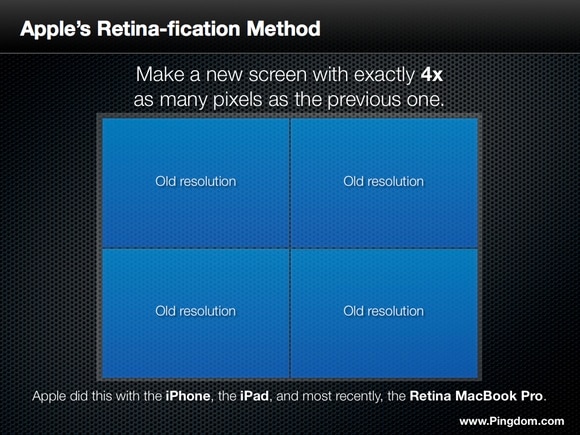![]()
Now that Apple has introduced the Retina display to the MacBook Pro line, it’s only a matter of time before it starts appearing on other Macs as well. What kind of screen resolutions can we expect once that happens?
The new 15-inch MacBook Pro has a 15.4-inch Retina display with a massive 2880×1800 resolution, or 220 PPI (pixels per inch). Apple quadrupled the resolution; you can fit exactly four “old” 1440×900 screens in the new one.
Let’s assume that 220 PPI is the target for Apple to call a laptop or desktop display “Retina.” They don’t want to go too far under that. The major criterion is that you shouldn’t be able to see the individual pixels of the display at a normal viewing distance.
Let’s also assume that Apple will use the approach of doubling both the horizontal and vertical resolution, like they did with the MacBook Pro with Retina display, and before that, the iPhone and iPad.

The future Mac Retina displays
How well does this method of doubling the horizontal and vertical display resolution work for all current Mac displays? Quite well, it turns out. Retina resolutions bolded:
- 11-inch MacBook Air: 1366×768 –> 2732×1536 = 270 PPI
- 13-inch MacBook Air: 1440×900 –> 2880×1800 = 255 PPI
- 13-inch MacBook Pro: 1280×800 –> 2560×1600 = 227 PPI
- 15-inch MacBook Pro: 1440×900 –> 2880×1800 = 220 PPI
- 21-inch iMac: 1920×1080 –> 3840×2160 = 205 PPI
- 27-inch iMac: 2560×1440 –> 5120×2880 = 217 PPI
Amazingly, the Retina version of the 11-inch MacBook Air would have more pixels than today’s 27-inch iMac.
In turn, the massive resolution of a 27-inch Retina screen would have 7.1x as many pixels as a full HD TV (which is 1920×1080).
Quick note: Apple will probably pick one single resolution for the 13-inch MacBook Pro and MacBook Air. Having two different resolutions like today doesn’t seem very good for production efficiency. Also, it would be weird if the 13-incher and 15-incher had the same resolution, so our guess would be the slightly lower 2560×1600 resolution for 13-inch Mac screens. On the other side that would put it below a doubled 11-inch display. So, time will tell.
This actually makes sense
This “scale” of PPI might actually makes sense, and would mirror the way resolutions are distributed between the different Macs today.
The smaller the screen, the closer you are expected to be to it. For example, the latest iPad has 264 PPI, which is pretty close to what the 11-inch MacBook Air would have with a doubled resolution.
We think this is pretty much what we’ll end up with. It may seem fantastic, but just consider that already today the new 15-inch MacBook Pro’s Retina display has more pixels than Apple’s 27-inch monitors. We’re set for a drastic leap in screen technology.
Final words
Why double the resolution? We’re no experts, but perhaps there are fabrication advantages to that. I.e. cram in exactly four new pixels in each old one. Or perhaps Apple just prefers to reuse the method it developed for creating the iPhone and iPad screens. It may have the technology for much of that already in place, so why reinvent the wheel?
Apple’s 27-inch monitors are pretty popular here around the Pingdom office. Lots of screen real estate, especially when you have two. We’re salivating at the thought of a Retina version.
So, Apple, when is that 5120×2880 27-inch display coming?
Data sources: We got the screen resolutions and exact measurements from Apple’s website, and for the PPI numbers we used the handy PPI calculator by Sven Neuhaus. Saved us some math juggling, so thank’s Sven!
Notes on display size: Apple’s 11-inch screen is actually 11.6 inches. The 13-incher is 13.3 inches, the 15-incher is 15.4 inches, and the 21-incher is 21.5 inches. Those are the measurements we used when calculating PPI. Just in case you’re counting along at home and your numbers don’t match ours.
Top image via Shutterstock.
























